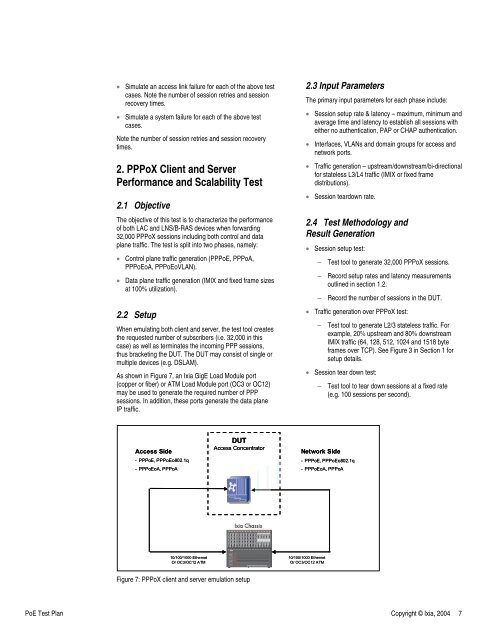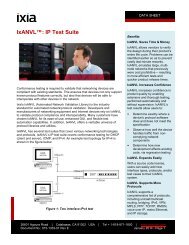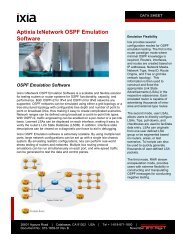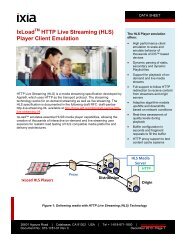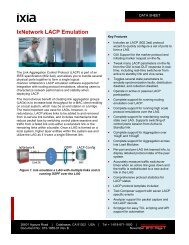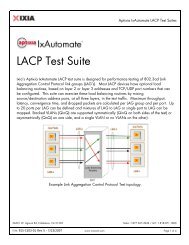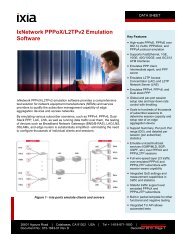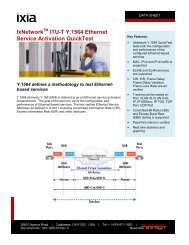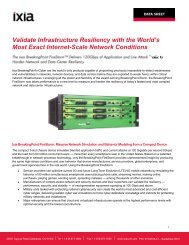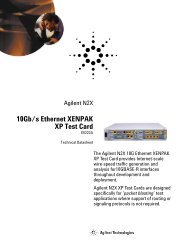Testing PPPoX and L2TP Broadband Access Devices - Ixia
Testing PPPoX and L2TP Broadband Access Devices - Ixia
Testing PPPoX and L2TP Broadband Access Devices - Ixia
You also want an ePaper? Increase the reach of your titles
YUMPU automatically turns print PDFs into web optimized ePapers that Google loves.
• Simulate an access link failure for each of the above test<br />
cases. Note the number of session retries <strong>and</strong> session<br />
recovery times.<br />
• Simulate a system failure for each of the above test<br />
cases.<br />
Note the number of session retries <strong>and</strong> session recovery<br />
times.<br />
2. <strong>PPPoX</strong> Client <strong>and</strong> Server<br />
Performance <strong>and</strong> Scalability Test<br />
2.1 Objective<br />
The objective of this test is to characterize the performance<br />
of both LAC <strong>and</strong> LNS/B-RAS devices when forwarding<br />
32,000 <strong>PPPoX</strong> sessions including both control <strong>and</strong> data<br />
plane traffic. The test is split into two phases, namely:<br />
• Control plane traffic generation (PPPoE, PPPoA,<br />
PPPoEoA, PPPoEoVLAN).<br />
• Data plane traffic generation (IMIX <strong>and</strong> fixed frame sizes<br />
at 100% utilization).<br />
2.2 Setup<br />
When emulating both client <strong>and</strong> server, the test tool creates<br />
the requested number of subscribers (i.e. 32,000 in this<br />
case) as well as terminates the incoming PPP sessions,<br />
thus bracketing the DUT. The DUT may consist of single or<br />
multiple devices (e.g. DSLAM).<br />
As shown in Figure 7, an <strong>Ixia</strong> GigE Load Module port<br />
(copper or fiber) or ATM Load Module port (OC3 or OC12)<br />
may be used to generate the required number of PPP<br />
sessions. In addition, these ports generate the data plane<br />
IP traffic.<br />
2.3 Input Parameters<br />
The primary input parameters for each phase include:<br />
• Session setup rate & latency – maximum, minimum <strong>and</strong><br />
average time <strong>and</strong> latency to establish all sessions with<br />
either no authentication, PAP or CHAP authentication.<br />
• Interfaces, VLANs <strong>and</strong> domain groups for access <strong>and</strong><br />
network ports.<br />
• Traffic generation – upstream/downstream/bi-directional<br />
for stateless L3/L4 traffic (IMIX or fixed frame<br />
distributions).<br />
• Session teardown rate.<br />
2.4 Test Methodology <strong>and</strong><br />
Result Generation<br />
• Session setup test:<br />
− Test tool to generate 32,000 <strong>PPPoX</strong> sessions.<br />
− Record setup rates <strong>and</strong> latency measurements<br />
outlined in section 1.2.<br />
− Record the number of sessions in the DUT.<br />
• Traffic generation over <strong>PPPoX</strong> test:<br />
− Test tool to generate L2/3 stateless traffic. For<br />
example, 20% upstream <strong>and</strong> 80% downstream<br />
IMIX traffic (64, 128, 512, 1024 <strong>and</strong> 1518 byte<br />
frames over TCP). See Figure 3 in Section 1 for<br />
setup details.<br />
• Session tear down test:<br />
− Test tool to tear down sessions at a fixed rate<br />
(e.g. 100 sessions per second).<br />
<strong>Access</strong> Side<br />
- PPPoE, PPPoEo802.1q<br />
- PPPoEoA, PPPoA<br />
DUT<br />
<strong>Access</strong> Concentrator<br />
Network Side<br />
- PPPoE, PPPoEo802.1q<br />
- PPPoEoA, PPPoA<br />
10/100/1000 Ethernet<br />
Or OC3/OC12 ATM<br />
10/100/1000 Ethernet<br />
Or OC3/OC12 ATM<br />
Figure 7: <strong>PPPoX</strong> client <strong>and</strong> server emulation setup<br />
PoE Test Plan Copyright © <strong>Ixia</strong>, 2004 7


